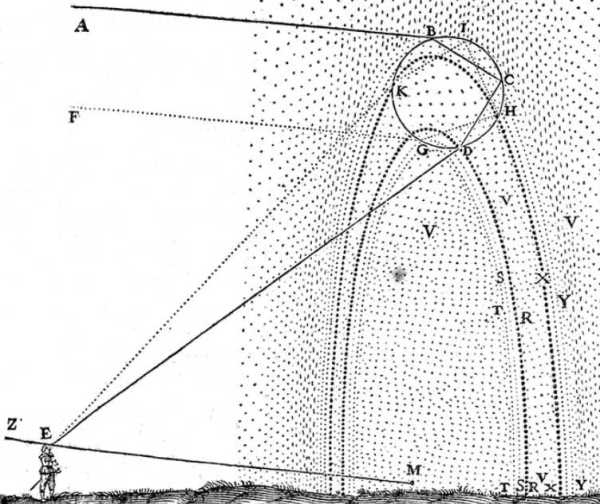The Rainbow
Table of Contents
Rainbow can appear in:
- the sky
- in the air near us whenever and wherever there are many drops of water illuminated by the sun
- An example is in near fountains
It is caused by the way that the rays of light act against these drops and turn them towards our eyes.
These drops are round. They create rainbows whether these droplets are large or small.
They do not make this arc appear in any other way: I decided to make a very large one, in order to be able to examine it better.
I filled a large glass sphere, completely round and very transparent, with water.
The sun came from the part of the sky marked AFZ with my eye at point E.

Line EM extends from the center of the eye to the sun’s center.
When I placed this sphere in the place BCD, its part D appeared to me to be all red, and incomparably more brilliant than the rest.
This part D always appeared equally red provided that the line DE always made a 42 degree-angle with line EM:
- whether I brought it closer or moved it back
- whether I placed it to the right or to the left, or even turned it in a circle around my head
But that as soon as I made this angle DEM a little larger, this redness disappeared.
If I made it a little smaller, it did not disappear all at once, but first divided as if into 2 parts, less brilliant, in which we could see yellow, blue, and other colors.
Then looking also towards the place of this sphere which is marked K, I perceived that making the angle KEM about 52 degrees.
This part K also appeared red, but not as bright as D.
- By making it a little larger, other weaker colors appeared there.
- By making it a little smaller or much larger, none appeared anymore.
From which I clearly knew that all the air which is towards M was filled with such spheres, or in their place with drops of water, there must appear a very red and very bright point in each of those of these drops whose lines drawn towards the eye E make an angle of about 42 degrees with EM, like I suppose those that are marked R.
These points being looked at all together, without otherwise noting the place where they are except by the angle under which they are seen, must appear as a continuous circle of red color.
There must be all the same points in those that are marked S and T, whose lines drawn towards E are angles a little sharper with EM, which compose circles of weaker colors.
This is what the first and main rainbow consists of.
Then again that the angle MEX being 52 degrees, a red circle must appear in the drops marked X, and other circles of weaker colors in the drops marked Y.
This is what the second and less main rainbow consists of.
In all the other drops marked V, no colors should appear.
What in sphere BCD made the part D appear red?
It was the rays of the sun which coming from A towards B curved into entering the water at point B.
It then went towards C and then they were reflected towards D where they bent again on leaving the water, tended towards E.
As soon as I placed an opaque body somewhere on the lines AB, BC, CD, or DE, this red color disappeared.
Even though I covered the whole sphere except for the two points B and D, and placed dark bodies everywhere else, provided that nothing prevented the action of the rays ABCDE, it still appeared.
What caused the red that appeared towards K and I?
It was the rays that came from F towards G, where they curved towards H. There, they reflected towards I where they were reflected again towards K, then finally curved at point K, and tended towards E.
The first rainbow is caused by rays that reach the eye after 2 refractions and 1 reflection.
The second rainbow is caused by other rays that only reach it after 2 refractions and 2 reflections. These prevent it from appearing as much as the first.
A third, much weaker rainbow has sometimes been seen above the 2 ordinary ones. It was about as far from the second as the second was from the first.
This could have happened if there were very round and transparent hailstones mixed with the rain. It could cause the refraction to be notably greater than in water.
The outer rainbow should have been much larger there, and thus appear above the other.
And for the inner one which by the same reason should have been smaller than the inner one of the rain, it may be that it will not have been noticed, because of the great luster of this one: or that their ends having joined, they will not have been counted both for one.
But for one whose colors will have been arranged differently than usual.
And this reminds me of an invention to make signs appear in the sky, which could cause great admiration to those who would not know the reasons.